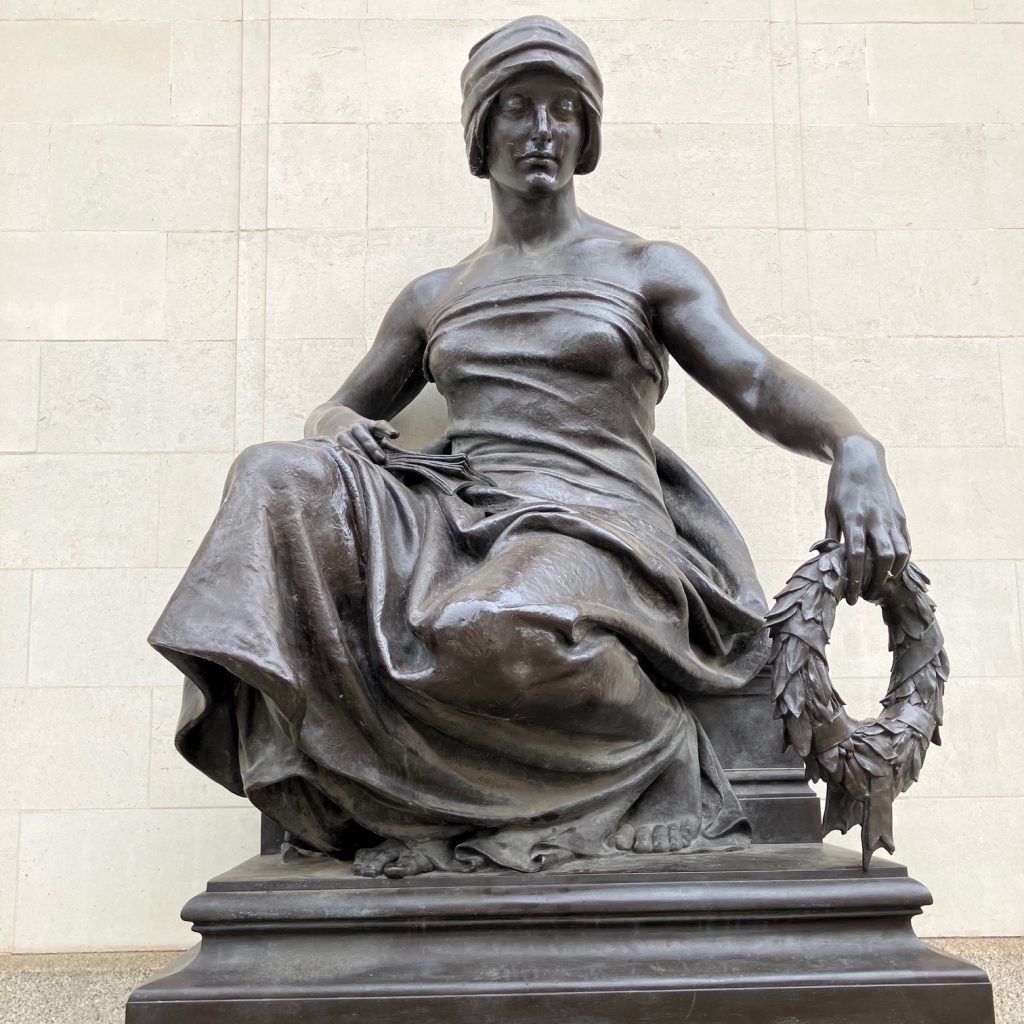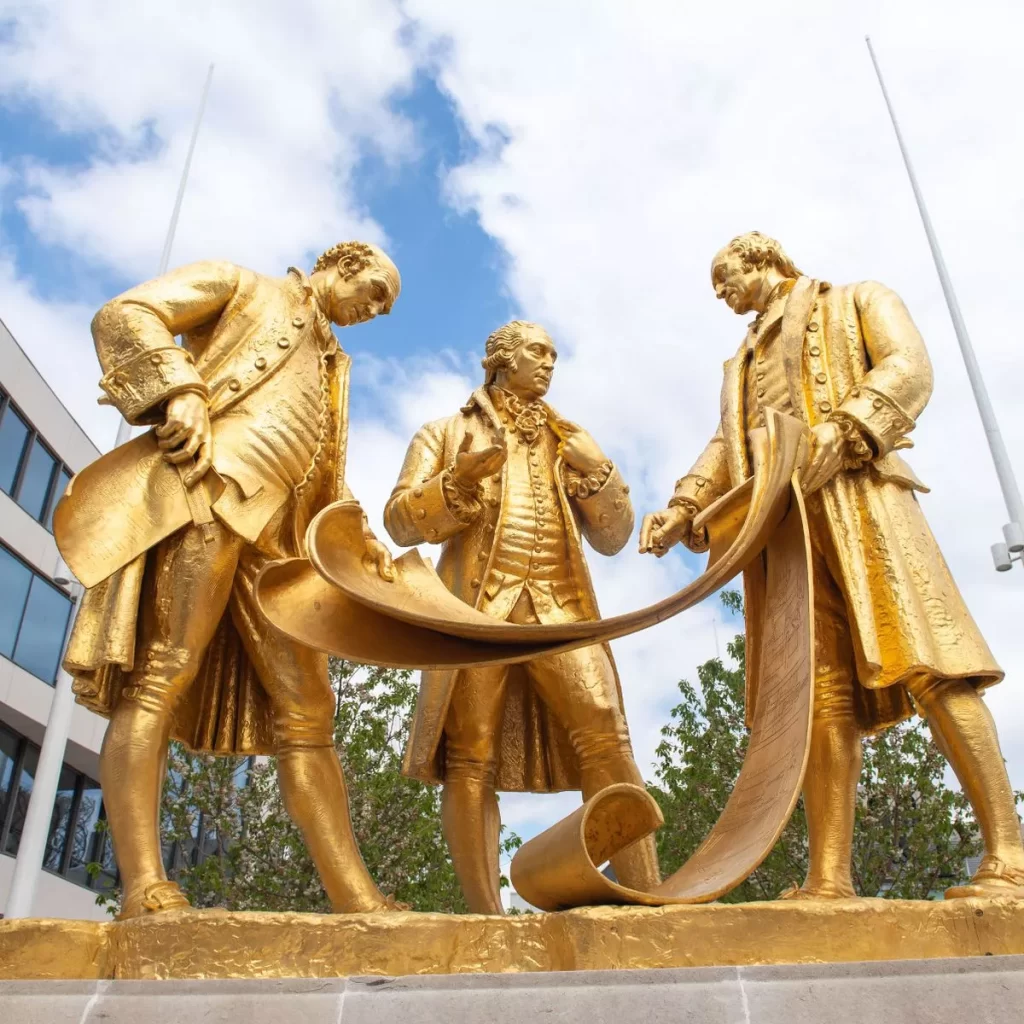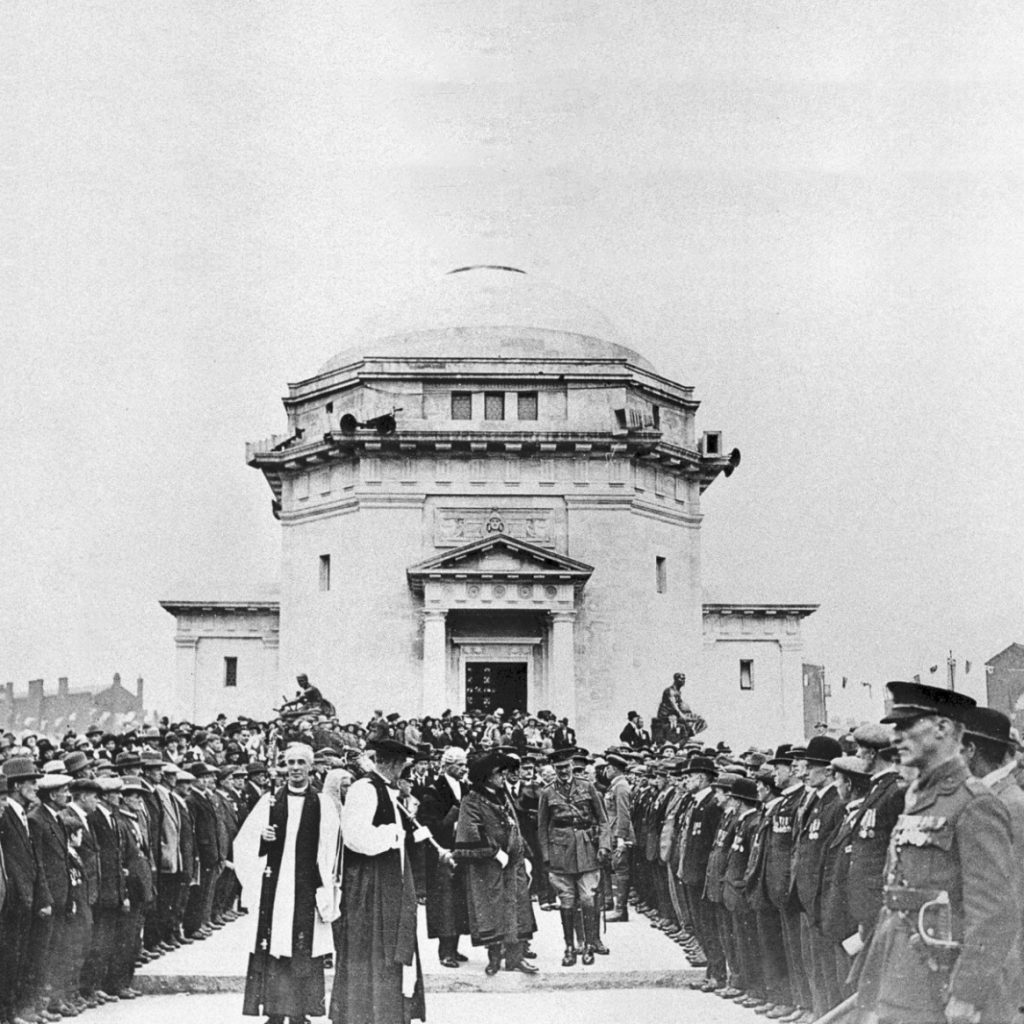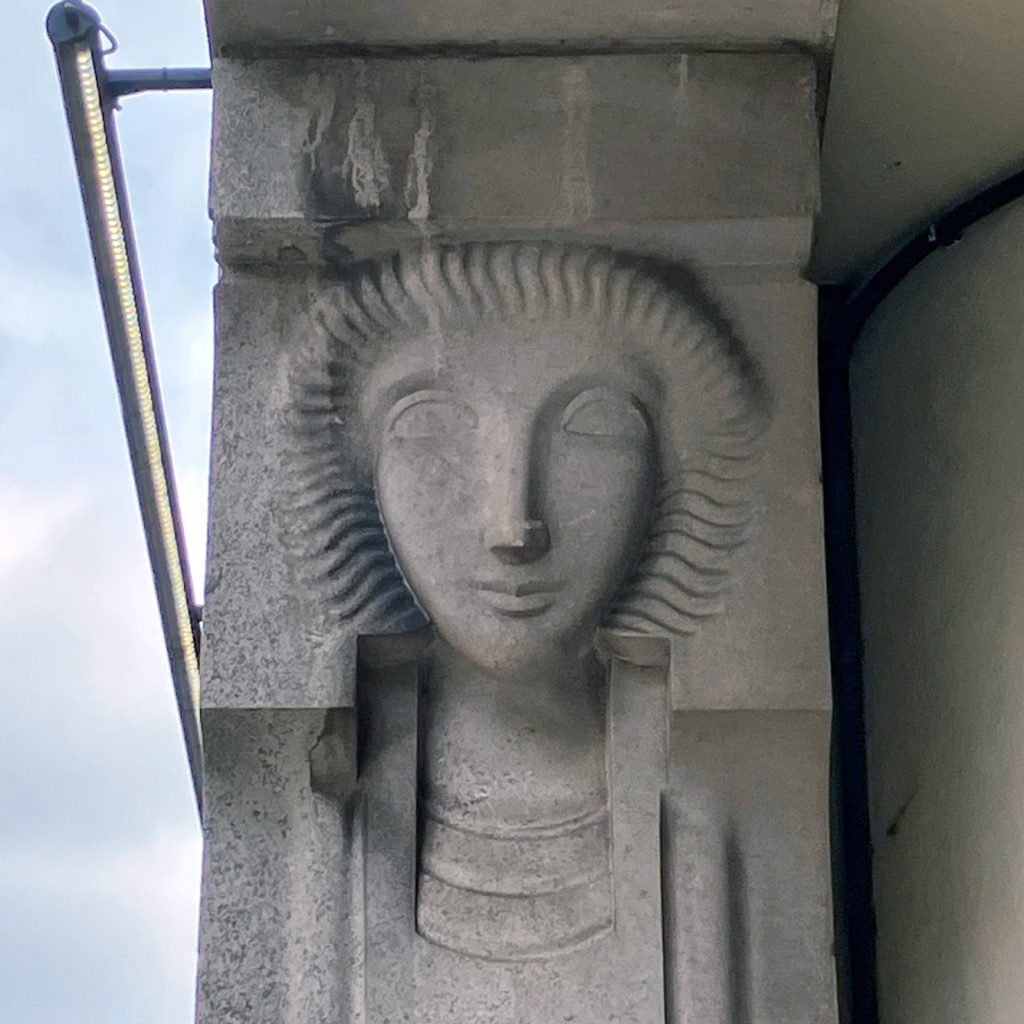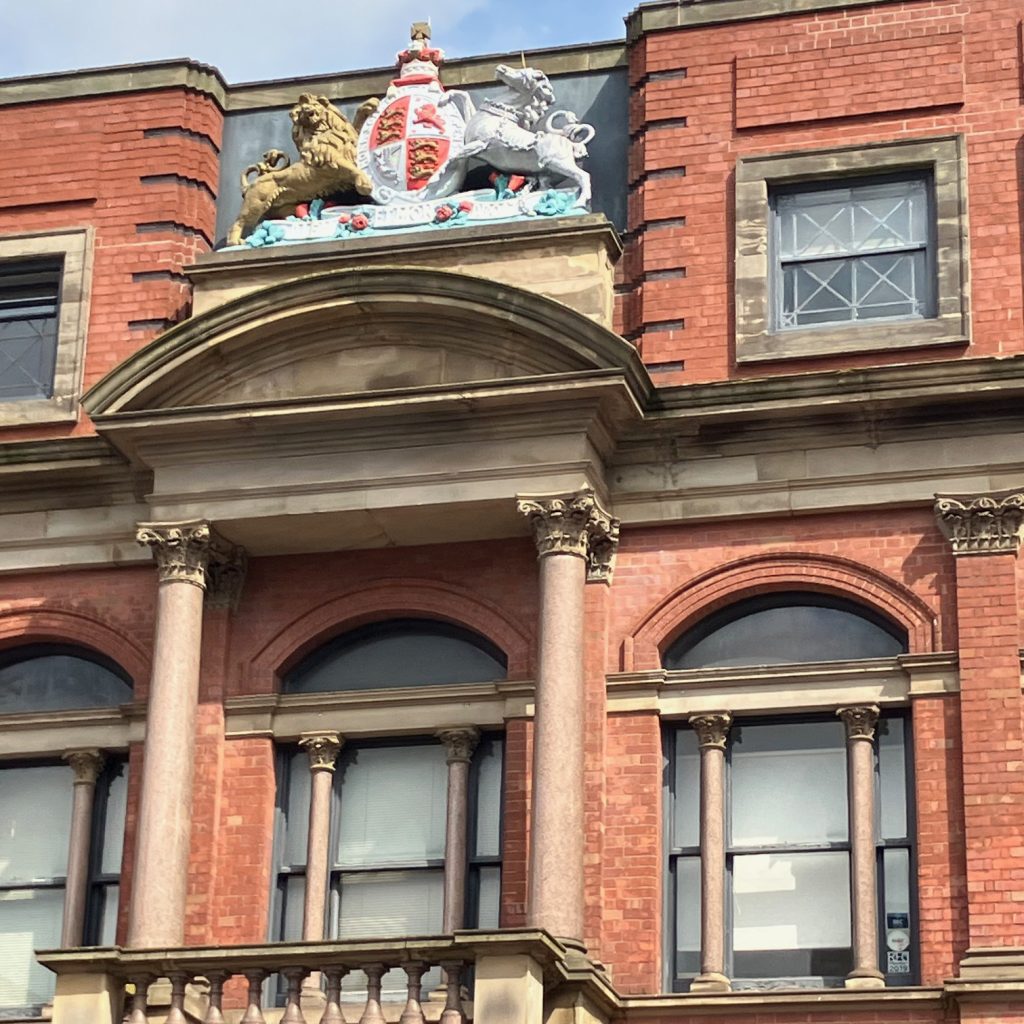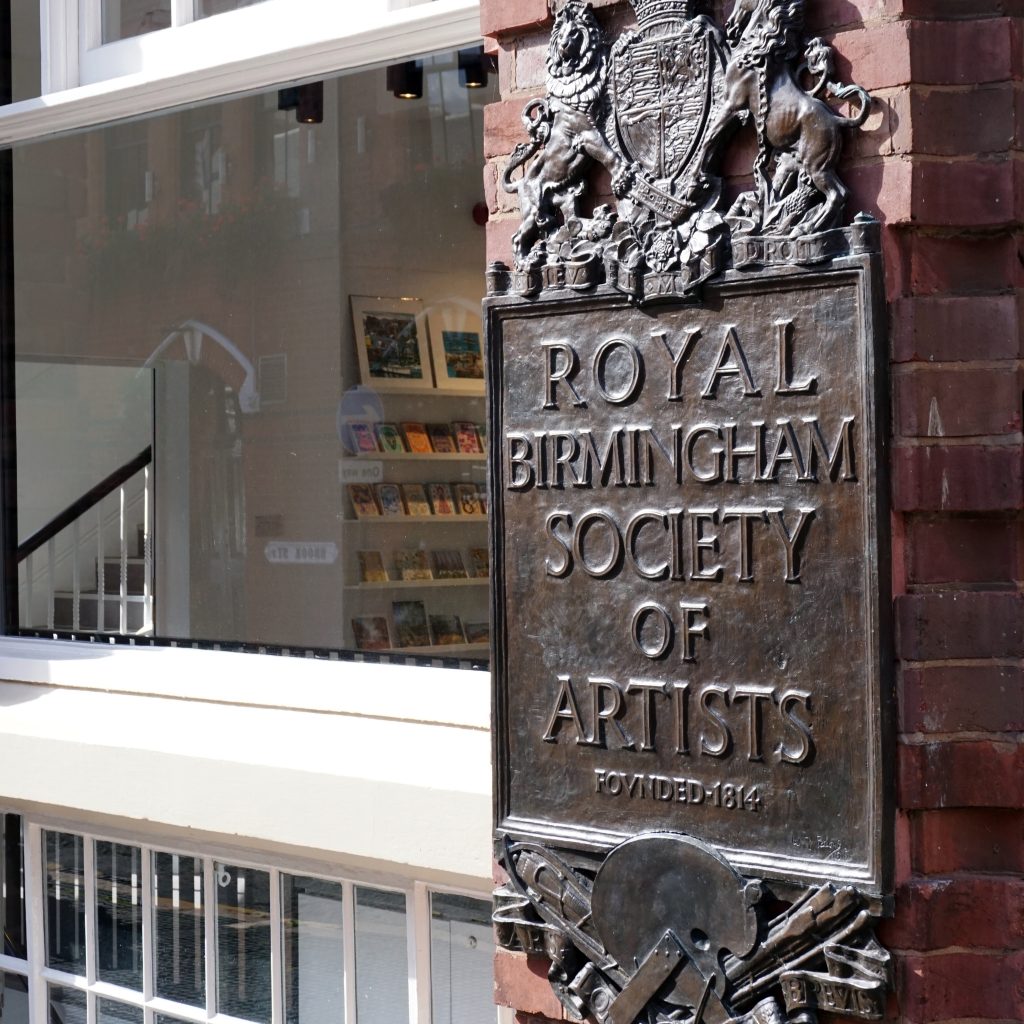Celebrating the Work of William Bloye PPRBSA
This text accompanies the city centre sculpture trail, a 2k walk through Birmingham City Centre taking in some of the public sculpture on display.
Leaflets outlining the location of the works and the route can be picked up from the Gallery, Birmingham Central Library, and branch libraries from Monday 30 June. Alternatively, the trail map can be seen at the bottom of this page.
1.
Boulton, Watt and Murdock – Boulton (1728-1809) was the Birmingham industrialist who founded the first large-scale factory making small metal goods as Soho Manufactory. He collaborated with James Watt (1736-1819) of steam engine fame to help increase the productivity of his factory. Murdock (1754-1839) was the youngest of the trio and a fine inventor who joined up with Boulton and Watt aged 23. The sculpture shows them looking at drawings of mechanical devices. It honours their contribution not just to Birmingham but the world. Funded initially by a bequest in 1939 by Richard Wheatley, it took 17 years to finish the commission with the City Council contributing £7,500. The medium is bronze with a gilt finish and is a rare example of Bloye’s free-standing work. As a result of its gilding, the sculpture is known popularly as ‘The Golden Boys’ and they are said to be looking a carpet sample from the nearby furniture retailer, Lee Longlands!
2.
Real Birmingham Family – Gillian Wearing RA is a Birmingham born (1963) Turner Prize winner and a conceptual artist. Probably best known for her statue of the suffragist Millicent Fawcett in Parliament Square, she was commissioned by the Ikon Gallery to make this work in 2014 following invitations to ‘real local families’ to apply to be modelled. Selected by an independent panel, Roma and Emma Jones with their two children Kyan and Shaye applied and were selected. By the time of the unveiling Emma’s new baby, Isaac, had been born. Wearing said ‘I liked how the Jones’ spoke of their closeness as sisters and how they supported each other…….a nuclear family is one reality but it is one of many and this work celebrates that idea that what constitutes a family should not be fixed’. It cost around £100,000 and the bronze was cast in China. The work has attracted some controversy.
3.
Industry and Genius – David Patten born 1954 in Wolverhampton studied fine art at Birmingham Polytechnic and the Royal College of Art. His sculpture celebrates the work of the Printer and Letter Founder, John Baskerville, who lived on the site of what is now Baskerville House, the only building with the Hall of Memory being part of a visionary plan for a new Civic quarter to be completed before WW2. Thereafter the plan was abandoned. Baskerville (1706-1775) was a very important figure in the publishing industry improving the printing press, inks and paper. The sculpture of six limestone columns topped by metal letters in the form of punches for printing use Baskerville’s type form. Virgil’s Bucolica was Baskerville’s first book published in 1757. The sculpture was completed in 1990. The ‘g’ is regarded as the most inventive of his lettering designs, which are still used today. A blue plaque commemorating Baskerville has recently been placed on the building.
4a.
Allegories of Army, Navy, Air Force and Women’s Services – Albert Toft, (1862-1949) the sculptor, was born and started training in Birmingham before being apprenticed as a modeller at Wedgwood. He established a studio in London and had a national practice. His four bronze figures, completed in 1924 stand on granite bases and represent the three Armed Services and Women’s services. Their presence is integral to the Hall of Memory with its octagonal shape. They are classical draped: whilst the men all look out, the woman is depicted in more contemplative mood. A critic wrote ‘it can truthfully be said that the sculpture is in harmony with the spirit of the architecture. Neither is violent, extravagant or small in its parts’ (LB Budden).
4b.
Reliefs of Call, Front Line and Return inside Hall of Memory – the Hall itself was designed by SN Cooke and N Twist and was to be part of the new Civic quarter. The architects left three spaces for reliefs, which Bloye designed and carved in limestone. They reflect the influence of his training with master carver and letter designer, Eric Gill. The Call shows the recruits bidding farewell and marching enthusiastically to war. It records that of 150,000 who answered the Call to Arms 12,320 fell and 35,000 came back injured. The Front Line represents fighting in the trenches from Bloye’s personal experience in WW1 and the poignant Return shows the ravages of war with injuries and the haunting repetition of the gravestones. This is regarded by some as Bloye’s finest work. It is also thought that Bloye carved the features on the outside of the building. The Hall of Memory, funded by public subscription was opened by the Duke of Connaught, a grandson of Queen Victoria on 4 July 1925 with 30,000 present.
5.
Allegory of Fame rewarding the Arts – look up to the triangular pediment over the entrance to the Museum and Art Gallery where in the centre Fame is personified seated with Painting and Architecture on the left and Sculpture on the right. Note the putti on the right with the sculptor’s hammer and chisel. Carved by Francis Williamson (1833-1920). Below that there is a complex frieze carved by John Roddis (1839-1887) who also completed the rest of the sculpture on this building and the impressive frieze carving on the Council House itself.
6.
Memorial to Joseph Chamberlain Fountain – commissioned from J.H. Chamberlain RBSA (1831-1883) (no relation to Joseph), the choice of a fountain was regarded as appropriate for one who had municipalised water and gas. Paid for by public subscription of £3,000, the plaque records Chamberlain’s achievements. The portrait medallion is sculpted by Thomas Woolner RA, the mosaics of water loving plants by the Venetian artist Antonio Salviate who also made the mosaics on the front of the Council House and the remainder of the Fountain was carved by Samuel Barfield (1830-1887). He and Chamberlain collaborated on the School of Art Foliage window and Barfield carved Chamberlain’s gravestone in Warstone Cemetery. The design has been criticised by Pevsner as ‘an ungainly combination of shapes’. The pool was refurbished by Birmingham Civic Society in 1994.
7.
Memorial to Thomas Attwood – first find his soap box, then the papers and his bronze sculpture reposes informally on the steps leading down to the Town Hall. Attwood was a social reformer, born in Halesowen to a Birmingham banking family. He formed the Birmingham Political Union in 1829 to widen the voting franchise and agitate on the importance of free trade. The Reform Act of 1832 started the movement to universal franchise and he, with Joshua Scholefield, were elected the City’s first MP’s. Sioban Coppinger modelled the figure and Fiona Peever designed the papers. They rejected the idea of placing Attwood on a plinth thus portraying him as a man of the people. The work was commissioned by Priscilla Mitchell, great-great-granddaughter of Thomas.
8.
Iron Man – a commission by Trustee Savings Bank when they set up their HQ in the former Post Office (just nearby) and realised by Anthony Gormley RA. The figure is Iron, weighs 6 tonnes and 6 metres tall and its feet are buried beneath the pavement. It leans at 7.5 degrees back and 5 degrees to the left. The sculpture was Untitled when installed and after a time Gormley asked for it to be named the Iron Man. He said that it is a celebration of the traditions of labour in Birmingham and the Black Country – it was made in Willenhall. The surface oxidation is to protect the underlying metal. ‘Unlike the good and the great in the Square it is concerned with the relationship between Birmingham people and their ‘place in the world’. TSB merged with Lloyds in 2013. Controversial when unveiled but now very much part of the city centre.
9.
Queen Victoria – originally the statute of Victoria was carved in granite by Thomas Brock RA (1847-1922) on the commission of W H Barber, the benefactor of the Barber Institute to commemorate her Diamond Jubilee in 1897. It was to be larger than the Victoria statue which Brock had made for his home city of Worcester. Brock was an important sculptor of his time being responsible for the Queen Victoria Memorial outside Buckingham Palace. It was unveiled 12 days before her death on 10 January 1901. But the City’s air pollution caused the granite to degrade* and Bloye was asked to make a copy in bronze partly funded by Birmingham Civic Society. It now stands on a Cornish granite base and was unveiled by Princess Elizabeth on 9 June 1951 when the Square was redesigned marking the Festival of Britain. Note the decoration on the dress: with roses, shamrock and thistle representing parts of the UK. *Whilst granite degraded, fortunately the City’s many terracotta moulded decorative features did not suffer the same fate – see venues nos 18 and 22.
10.
Britannia and Supporters – look up to the triangular pediment at the top of the Council House. The architect of the Council House, Yeoville Thomason, designed this work showing a classical Britannia in the centre holding laurel wreaths as an accolade over two of the city’s factory owners in contemporary dress. The other four figures are in work clothes with rolled up sleeves operating tools and displaying goods. They are all carved, not in relief, but as completely free-standing figures unlike the other decorative elements on the building. The other pediments on the front of the Council House represent The Union of Arts and Science (left) and Literature (right). Notice also the mosaic over the entrance, which is the work of Salviati with the central figure of Municipality handing out two scrolls labelled Stability and Power!
11.
River, Youth, Guardians and Object (Variations) – the City Council held an open competition for a work to fill the Square and it was won by Dhruva Mistry, who was the youngest RA to be elected since Turner. The commission insisted that water should be an important element of the work to provide a link both with the Chamberlain memorial and by cascading to the lower level of New Street. Water has a life-giving property with the Matisse-like female figure of River at the centre. It flows down to Youth in the lower pool comprising a male and female figure facing each other sitting on a cube and a cylinder with an egg and cone in the water – all symbolic of life. The sphinx-like Guardians are the equivalent of the lions in Trafalgar Square as an embodiment of civic pride and protectors of the site. The male has stylised wings and the female feathers. The two sandstone columns are the boundary markers of the site. A quote from TS Eliott has been carved by Bettina Furnée round the top pool and captures the mood of the cycle of life and time passing.
12.
Capitals and Pediment Sculpture – SN Cooke a co-designer of The Hall of Memory was the architect for New Oxford House – now occupied by Adams, the Michelin-starred restaurant. Bloye was his collaborator as with many other buildings to add sculptural features to the building. The two Egyptian style heads face each other in the entrance – one now partly and unsympathetically obscured by some electrical equipment. They are very reminiscent of a Jacob Epstein head. Above is a putti holding a cornucopia symbolising abundance – highly appropriate for Adams! Bloye also made some sculptural interventions on the property next door, Neville House designed by N Twist of Hall of Memory fame, recently confirmed by his Sales Ledger.
13a.
Coats of Arms and Supporters – at the top of the Lost and Found building on the corner of Bennetts Hill and Waterloo Street. Samuel Lynn (1834-1876) was commissioned to carve in stone this free-standing Coat of Arms when the National Provincial Bank rebuilt the building in 1869. Birmingham was not a City at the time nor had it an approved Coat of Arms. But the bank wanted to portray the image of confidence and permanence at a time of banking crises. So the unofficial Coat of Arms and Supporters were intended to purvey authority and importance and be essential symbols to its customers and community. Unusually the left-hand figure is female representing the Arts leaning on a classical pitcher whilst on the right Industry is in work clothes holds a hammer and dividers. Birmingham achieved city status in 1889 and a Coat of Arms.
13b.
Industry and Manufacturers in Birmingham – Lynn also made in stone the four scenes inside the porch of the pub illustrating trades of the City. They are gun-making, glass blowing, electroplating and metalworking.
14.
Sun Emblem and Lettering – an early work by Bloye, with SN Cooke as the architect, in stone and gilded for another Insurance Company. Bloye was to use gilt and painted letters throughout his career both on stone and wood for signs and emblems on buildings.
15.
Lettering for the Birmingham Banking Company – now The Cosy Club, the original building of 1830-1 was designed by Rickman and Hutchinson, well-known nationally for their Gothic Revival style. The building was modified by the architect of the Council House, Yeoville Thomason, who introduced the curved entrance but the florid lettering ‘BBC’ by an unknown hand survived. The bank, which was an investment/joint stock bank, collapsed in 1866. Birmingham has an interesting place in banking history being the birthplace of Lloyds founded in 1765 in Dale End as Taylor and Lloyds. Birmingham and Midland Bank started in 1836 in Union Street and survived as the Midland Bank and occupied this building. It grow to be a High Street bank. Its HQ moved to London in 1898. Now it is part of HSBC whose UK retail HQ moved back to the City in 2018 occupying the Office opposite the Hall of Memory. So two of the big four banks started in the city. The city also established the first Municipal Bank for savings through an Act of Parliament in 1916 (it moved to what is now The Exchange by the Hall of Memory in 1933) and ultimately merged with the TSB.
16.
Wisdom, Fortitude, Charity and Faith – look high up on the front and side of the L&G building, designed by SN Cooke but Pevsner attributes the design to his assistant, Edward Holman. Four figures are carved in limestone. Wisdom has symbols of the tree of life and an owl: Fortitude holds a large decorated sword: a female Charity protects a child whilst Faith has hands in prayer with a flame. These sculptures capture the style of the time. The entrance also has the gilded emblem of the company by Bloye.
17.
Ghilberti and Cellini – at the second storey of the building which was built for William Spurrier, a silversmith and metalworker as his showrooms. Designed by architect JA Chatwin (1830-1907), an RBSA member, but possibly carved by Bridgeman & Co of Lichfield. Chatwin was articled to the best known architect of the time, Sir Charles Barry, and travelled to Italy. These two roundels of artists from the Italian Renaissance: Lorenzo Ghilberti (1378-1455) was the creator of two bronze doors to the Florence Baptistry often regarded as masterpieces of the early Renaissance. Benvenuto Cellini (1500-1571) was a goldsmith and sculptor best known for his Gold Salt Cellar and his sculpture of Perseus. A simply dressed Ghilberti looks down onto the street quite passively whilst Cellini appears argumentative and more grandly dressed wanting to engage with passers-by.
18.
Saint George and the Dragon – stand on the right hand side of Newhall Street so you can look across at 56 to 60 now a Cafe. The sculptures in buff terracotta by William Neatby (1860-1910), he was a master designer/modeller in a number of materials and had a national practice. He worked for a time for Doulton in charge of architectural design. Each of the four reliefs of the figures of George and the Dragon consist of four separate panels – two are slightly obscured by drainpipes. The terracotta house numbers also reflect the Arts and Crafts style of the 1900’s.
19.
Aesculapius and lettering – stand on the north side of Great Charles Street. The Chest Clinic designed by architect FJ Osbourne (with whom Bloye also had many collaborations) was constructed as a result of concern about the rise of chest diseases particularly TB. The winged Aesculapius is the Greek god of medicine and holds a Caduceus in one hand and a bowl from which a serpent drinks in the other. These are symbols relating to health and healing and therefore relevant to the purpose of the building. Bloye carved a later Aesculapius over the entrance to Birmingham University Medical School in 1938. The lettering is also by Bloye. The gold leaf is still just evident.
20.
Female Allegories of Art and Industry – look across the road (no need to cross) at the rear of the Art Gallery and Museum. This sculpture has been attributed to William Bloye but that is doubted as that scale of work would in all likelihood be well beyond his capabilities at that time. He would have been in his early 20’s and still training. It is probably the work of WB Fagan (1881-1935) who had a practice based in London. The female figures represent Art on the right with a palette and Industry to the left with a mechanical device. In between them is the ‘genuine’ Coat of Arms with the City’s motto ‘Forward’. Bloye may have been involved in some bomb damage restoration following WW2.
21.
Caduceus and Lion Heads – only recently established as a William Bloye work, confirmed by reference to his Sales Ledger. The Caduceus is the wand carried by Mercury as the winged messenger for the gods. The building is known as Telephone House, designed by CR Fowler, HM Office of Works, so its function was one of communications. The Art Deco surround is very contemporary and the lions emblematic of a building of status. There are more lion heads on the Lionel Street frontage and inside the entrance. The metalwork over the entrance with the date 1935 is attractive.
22.
M&B sign The Queens Arms – a fine example from 1901 of a town pub with painted stone and ceramic and tile decoration with moulded brick proudly announcing the brewery name and the winning quality of its beer. The M&B Corporate Head Office is just nearby in Fleet Street. A listed building.
23.
Coat of Arms – look up to the top of the Assay Office from 1878. This Office was the centre for the testing and hallmarking of all precious metals for over 130 years. Birmingham’s Assay Office was established by Matthew Boulton (we met him earlier) in 1773 following a successful petition to Parliament to allow Birmingham to stamp its own goods rather than have to transport them to London or Chester. After drawing lots with Sheffield, the City’s hallmark is an Anchor. The Assay Office moved in 2016 to a larger site on the edge of the Jewellery Quarter and this building converted to offices and flats. The Coat of Arms is an important part of the iconography of the Assay Office as a prestigious official building. It is claimed to be the busiest Assay Office in the UK now having testing facilities for many different metals.
24.
RBSA Plaques – these are Bloye’s first public art works and unusually, signed by him. The raised lettering lacks the precision and fluidity of his later work following his two four-weekly training sessions with Eric Gill in 1921-2. They show the nature of the organisation with artists materials at the base and the royal coat of arms at the top denoting royal patronage granted to the Society in 1879. The building has been the home of the RBSA since 2000 and the plaques were made originally for the gallery in New Street. Bloye was elected an Associate Member in 1919 and a full Member in 1930, served as Professor of Sculpture for many years and elected President of the Society from 1948-1950. Visit the Gallery on three floors to see what the contemporary artists in Birmingham and beyond are showing today.
Full trail map
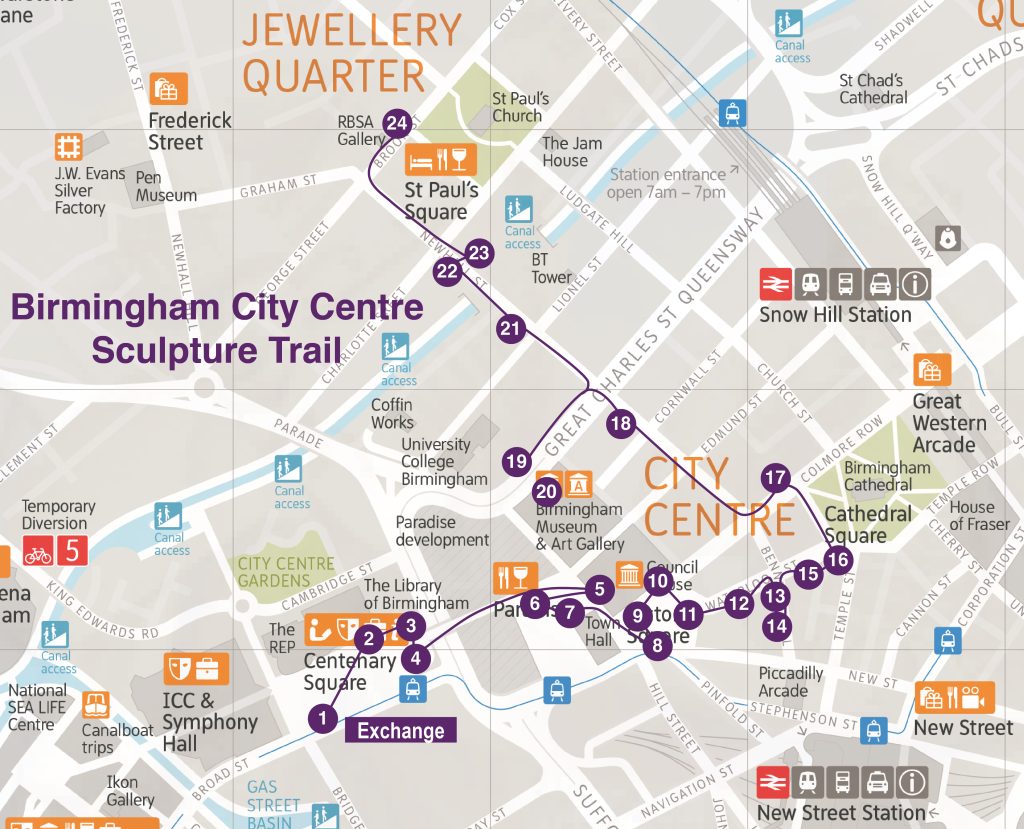
About William Bloye
William Bloye was born in 1890 in Birmingham and died in Italy 1975 where he moved for his last few years. He was educated at the School of Art and, from 1914, at the Royal Academy School, after which he went to serve in WW1. Appointed a lecturer in modelling at Margaret Street School of Art in 1919, he worked there until he retired in 1956. In 1921/2, Bloye went to Eric Gill’s studio at Ditchling, Sussex, for two periods of four weeks to improve his stone carving and lettering skills. That experience had a profound impact on his future work. By 1925 he had bought a studio in Golden Hillock Road which he maintained until 1959, and employed a number of very capable assistants whom he had trained. He was elected an Associate of the Royal Birmingham Society of Artists in 1919, a full Member in 1930, and was President between 1948-50. He was also a Fellow of the Royal Society of Sculptors.
Bloye’s first public work was the RBSA plaque: the 1998 book on Public Sculpture in Birmingham records 370 works in the city, of which 51 were by Bloye. As well as his works elsewhere, many of those were executed in collaboration with architects working in the city. Through the RBSA and Birmingham Civic Society, which he joined in 1925, he built up a network of architects, for whom he was the obvious choice for sculpture on any new building. He became known as Birmingham’s Civic Sculptor, but I am discovering he worked in other parts of England as well as having commissions in Canada and for the Royal Palace in Baghdad (probably destroyed).
An important body of his work is in the Black Country, with his known work on Dudley Council House, Dudley College, his Apollo figure in Coronation Gardens, but also at St Francis of Assisi Church in Friar Park, West Bromwich, where recently uncovered evidence confirms his work including, his plaster mouldings. His practice extended to Leeds University, Oxford and Cambridge Colleges, East Anglia, Southport Law Courts, Reading College, and Worthing to name a few. The full extent of his work is gradually being uncovered. He was unsuccessfully nominated for election to the Royal Academy over 30 times, it is believed that his location in Birmingham and his reputation as the Civic Sculptor did not help his cause against London based sculptors.
Nevertheless, William Bloye has left a mark on Birmingham’s heritage as a formidable architectural sculptor with libraries, police stations, schools, banks, and many pubs bearing his work. That is worthy of wider recognition and celebration and we hope this trail will have helped in that.
Sources:
Public Sculpture of Birmingham, George Noszpopy, 1998
Birmingham Public Sculpture Trails, George Noszlopy and Fiona Waterhouse, 2007
Birmingham’s Public Art, Jonathan Berg, 2023 (on sale at the RBSA Gallery)
Birmingham and the Black Country, Pevsner Architectural Guide, 2022
Various websites
Copyright – Viv Astling OBE PPRBSA 2025



